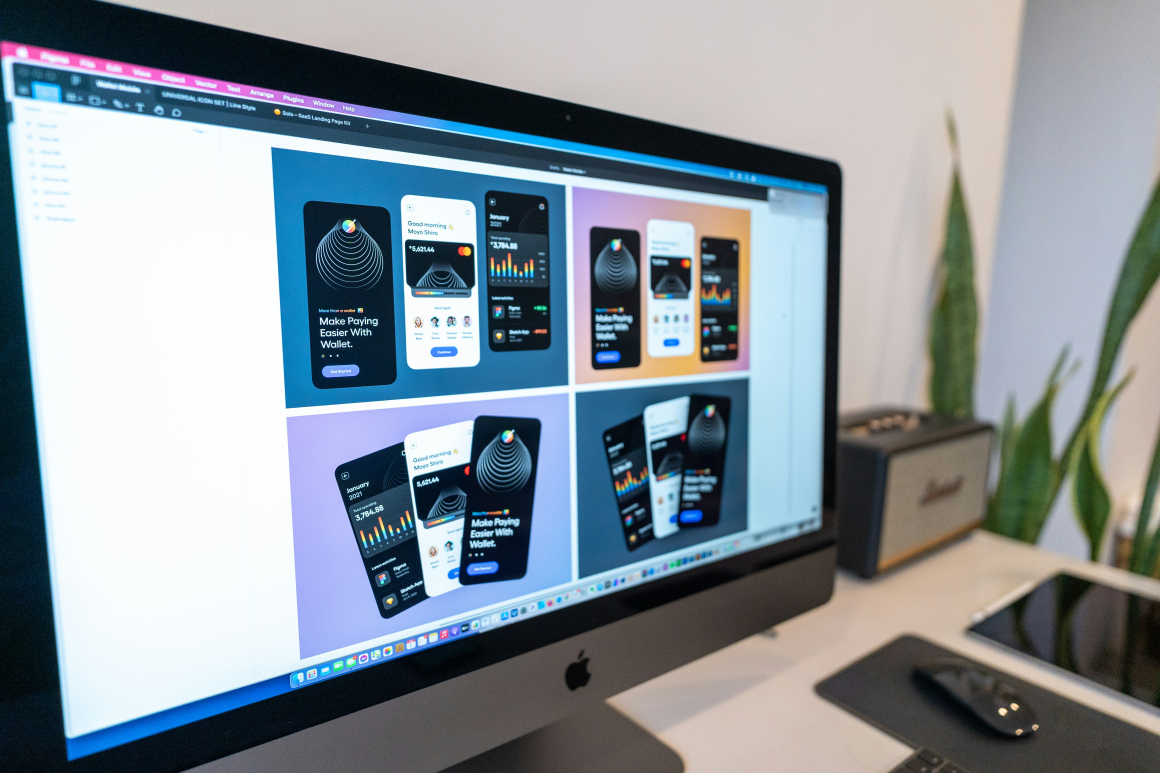UI/UX Designers: Navigating the Intersection of Function and Form
UI/UX designers play a pivotal role in shaping digital products that are appealing to consumers while also meeting business objectives. UI/UX designer job responsibilities focus on creating intuitive and visually pleasing interfaces for web and mobile applications. They aim to enhance application accessibility and user experience by making interfaces easy to navigate.
The work of UI/UX designers combines artistic sense, with technical expertise to build products that can benefit the final consumer. But what exactly does a UI designer do on their jobs, and how is the IT market shaping their career trajectories? What are the qualifications necessary to become a UI/UX designer, and is there a market for UX designer jobs abroad?
Read this article to get a detailed overview of the UI/UX designer career path, including the job responsibilities and future opportunities available to budding UX designers.
Key Responsibilities of a UI/UX Designer
A UI/UX designer handles a combination of tasks that revolve around creating intuitive user interfaces that enhance user experience. Here are five key responsibilities of a UI/UX Designer’s job:
1. User Research and Analysis
UI/UX designers research to study the motivations and behaviors of users. This helps them understand the needs and pain points of their target audiences. This involves conducting surveys, interviews, and usability tests to gather insights about how users are interacting with applications. The information gained in this step is analyzed and compiled to create an ideal user persona that guides further decision-making in the design process.
2. Prototyping and Visual Designing
Wireframing is the process of sketching the basic layout of web pages or apps. A wireframe is used to create interactive prototypes of applications that simulate the final product. The creation of prototypes helps UI designers visualize and iterate on design solutions before they start building the actual product. After interactive testing and gathering feedback, designers create a final visual layout with detailed attention to color, typography, and aesthetics.
3. Interaction Design
The visual design element of the UI/UX design process is concerned with creating appealing interfaces that align with the brand identity of an app. After completing this step, designers are concerned with creating an interactive user interface that can offer smooth navigation and accessibility. This step focuses on building intuitive user flows, defining interactive behaviors, and optimizing buttons and animations to create an enhanced user experience.
4. Usability Testing
UI/UX designers focus on gathering and assimilating user feedback as their designs aim to improve user experience. For this, they need to organize usability testing sessions to gather reliable user assessments of their prototypes. The feedback collected is then analyzed to identify user pain points and areas of improvement. The duties of a UI/UX designer include incorporating diverse user needs to build inclusive application interfaces that cater to a wide audience.
5. Communication and Collaboration
UI/UX designer tasks include collaborating closely with cross-functional teams which are made up of developers, product managers, and other stakeholders to translate their design vision into the final product. Effective communication skills are required to present design concepts, gather feedback, and advocate for user-centered design while ensuring alignment between design goals and business objectives.
The Daily Duties of a UI/UX Designer in the Tech Industry
UI/UX designing is a creative process that involves multiple stages of design and testing tasks. The duties of a UI/UX designer vary according to the products they are creating, the industry they choose, and also the stages of interface development they are a part of. Every designing procedure aims to ensure that an application delivers the optimal user experience, while also meeting business objectives.
Here are some daily duties of a UI/UX designer in the tech industry:
- Creating user-friendly websites and mobile apps that reflect a brand’s voice in a visually appealing way.
- Developing visual representation of a product in the form of wireframes that include layouts, color schemes, and other interactive elements.
- Building design prototypes that focus on the overall feel of an application, and trying to make them as intuitive and accessible as possible.
- Collaborating with software developers to communicate design specifics and ensure that the final designs are implemented as intended.
- Aligning design objectives with product management processes to create apps that can deliver business goals.
- Working on developing a comprehensive design strategy by combining insights from various stakeholders, and departments.
- Interacting with consumers to gather feedback on design prototypes through surveys, interviews, and user-testing cycles.
- Researching to study user behavior, and analyzing the needs of different consumer demographics to create accessible user interfaces.
- Interpreting feedback to undertake iterative improvements aimed at improving product functionality.
- Presenting design prototypes to business leaders and stakeholders for feedback, and final approval.
As mobile apps, web platforms, and emerging technologies such as AR/VR continue to proliferate in the world of tech, the demand for UI/UX designers is expected to grow in the future. Consequently, UI/UX design is an evolving field that can offer fulfilling career options for creative and analytical minds.
Educational Pathways: UX Designer Degree Requirements
A UI/UX designer needs to be an expert in understanding what a user needs from an app and be able to deliver it in the form of a workable interface. To be effective at this job, you will need a combination of knowledge that lies in an intersection of web development, designing, and behavioral psychology.
Although UI/UX designing does not require a specific degree, having a background in computer science, or graphic designing is usually preferred. More than a degree, you will need to be a fast learner who is passionate about understanding how technology can be delivered to help people. Many UI/UX designers hold bachelor’s degrees in fields such as graphic design, interaction design, psychology, sociology, human-computer interaction, and computer science.
As UI/UX designing is a new and rapidly evolving field, most aspiring designers opt to take online courses, and workshops offered by websites such as Coursera, or Udemy. These programs provide designers with practical skills and industry-specific learnings about how they can apply UI/UX design principles to work on real-world projects.
Exploring UI/UX Designer Job Opportunities Worldwide
As businesses prioritize user-centric designing to create engaging digital experiences, we notice a proliferation of UI/UX job opportunities worldwide. Major tech hubs like Silicon Valley, New York City, London, and Berlin are offering numerous job opportunities for UI/UX designers. Skilled designers can find a range of job positions within the IT industry and work with tech giants, startups, or design agencies across the globe.
Emerging tech markets in Asia, including Bangalore, Singapore, and Shanghai are also showcasing a growing demand for talented UI/UX designers. With remote work options becoming common in the IT world, designers can now collaborate with global teams and take up multiple projects from a diverse clientele.
As most businesses and industries are evolving to build an online presence, companies are consistently seeking skilled UI/UX designers to enhance the usability of their services. Some popular industrial niches for designers include e-commerce, fintech, healthcare, social networking, and entertainment.
Find a high-paying UI/UX designer job with VeriiPro!
Although the tech industry is brimming with exciting job opportunities for UI/UX designers, landing the perfect position for your unique skill set can be challenging. Every company seeks out designers who can do justice to their product niches, while designers look for companies that can further their career objectives. In such a scenario, job seekers need to develop a refined understanding of industry expectations and hone their skills to be marketable in the niche of their choice.
VeriiPro is a professional networking platform that helps UI/UX designers find unique job positions to catapult their careers toward success and steady growth. It works by streamlining the job search process for its members by providing them access to exclusive job listings, and personalized support to land the right opportunities.
If you are a UI/UX designer who aspires to advance your career in tech, join VeriiPro today!
FAQs
What are the primary responsibilities of a UI/UX designer?
UI/UX designers are responsible for creating intuitive and aesthetically pleasing interfaces for digital products. They focus on enhancing user experience by ensuring that the design is accessible and easy to navigate.
What does the creative process of a UI designer entail?
The creative process for a UI designer involves researching user needs, creating wireframes and prototypes, testing designs for usability, and iterating based on feedback to improve the interface.
Are there UI/UX designer job opportunities available worldwide?
Yes, there are global opportunities for UI/UX designers as companies around the world recognize the importance of good design in digital products. Remote work options also expand the job market for these roles.
What educational pathways can lead to a career in UX design?
A career in UX design can be pursued through various educational pathways, including degrees in design, human-computer interaction, psychology, or related fields, as well as through bootcamps and online courses.
What are the day-to-day duties of a UI/UX designer in the tech industry?
Daily duties of a UI/UX designer may include conducting user research, collaborating with product teams, designing interfaces, prototyping, and conducting usability testing.
How can VeriiPro help me land a UI/UX designer job?
VeriiPro streamlines the job search process by providing access to exclusive job listings, resources for career development, and personalized support to help candidates find the right job opportunities in the tech industry.
Does VeriiPro offer exclusive job listings for UI/UX designers?
Yes, VeriiPro may have exclusive job listings for UI/UX designers that are not available on other job platforms, providing unique opportunities for job seekers.
What if I don’t have enough years of experience for a UI/UX designer role?
VeriiPro can assist candidates with varying levels of experience by matching them with suitable job openings and providing guidance on how to showcase their skills effectively to potential employers.
Are all UI/UX designer jobs remote, or are there in-office opportunities as well?
While many UI/UX designer jobs offer remote work options, there are also in-office opportunities available depending on the employer’s requirements and the candidate’s preferences.
Which UI/UX designer jobs typically pay the best?
Salaries for UI/UX designer roles can vary widely based on factors such as experience, location, and the specific company. However, roles that require specialized skills or seniority typically offer higher compensation.








